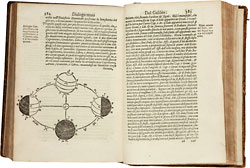 Ian McKay’s weekly column in Antiques Trade Gazette has been running for more than 30 years.
Ian McKay’s weekly column in Antiques Trade Gazette has been running for more than 30 years. Under the Sun
Heliocentric Heresies
Galileo Galilei, Dialogo… sopra I Due Massimi del Mondo. Tolemaico, e Copernicano, $65,725 at Heritage Auctions, Beverly Hills, September 13-14.
In cataloguing a 1632, Florence first edition, the auctioneers turned to the editors of Printing and the Mind of Man for a precise summation of its intent and significance, something I have done many times before writing my own reports and am happy to do here.
The Dialogo, which takes the form of a discussion between three radical, conservative, and agnostic friends, was Galileo’s attempt to slip the truth of Copernican astronomical theories and the revelations of his own telescopic discoveries past the censors and the stifling hands of the church, in the form of the Inquisition.
It was a dangerous challenge to authority, but designed, says PMM, “both as an appeal to the great public and as an escape from the silence” that had been effectively imposed on him since 1615.
“It is a masterly polemic for the new science. It displays all the great discoveries in the heavens which the ancients had ignored; it inveighs against the sterility of willfulness, and ignorance of those who defend their systems; it revels in the simplicity of Copernican thought and, above all, it teaches that the movement of the earth makes sense in philosophy, that is, in physics.”
Pope Urban VII, who ordered Galileo’s arrest, believed that he was being mocked in Simplicio, the character in the Dialogo whose steadfast adherence to the old geocentric doctrines of Aristotle and Ptolemy were mocked. Galileo was dragged before the Inquisition in 1633, charged with heresy, and forced to abjure all that he had professed to believe in his Dialogue on the Two Chief Systems of the World.
However, as the PMM editors conclude, this, “far more than any other work, made the heliocentric system a commonplace. Every fear of Galileo’s enemies was justified; only their attempts to stifle thought were in vain.”
In a worn and repaired but contemporary calf binding, this copy had the engraved frontispiece by Stefano della Bella, showing Aristotle, Ptolemy, and Copernicus in discussion, was present only in facsimile, which restricted the price, but just last October, when Sotheby’s London sold the first portion of the Library of an English Bibliophile that I have referred to elsewhere in these reports, another copy reached £93,250 ($147,335).
An Advance on Hemingway’s Masterpiece
Ernest Hemingway, For Whom the Bell Tolls, $25,095 at Heritage Auctions, Beverly Hills, September 13-14.
Bound in the same oatmeal cloth, but slightly taller than the regular trade issue and with uncut edges, this 1940 first of Hemingway’s novel of the Spanish Civil War is one of just fifteen advance issue copies intended for presentation by the author.
No dust jacket was produced for this issue and the binding shows quite a bit of soiling, while the spine has darkened. The pages show some spotting and staining throughout, mostly marginal, but on the front free endpaper it is inscribed, “For Popsie and Frankie Steinhart from their friend and neighbor this copy of the 15 original edition copies of this book. Best always, Ernest Hemingway.”
The Steinharts were Hemingway’s neighbors whilst he was living in Havana, Cuba.
In 2002, another of these very rare special copies, inscribed to Nathalie Walbridge of Scribners made $32,200 at Swanns in New York, but the dedication copy that Hemingway inscribed for his then new and third wife, Martha Gellhorn, made $310,400 when sold as part of the Neville Collection at Sotheby’s New York in 2004.









